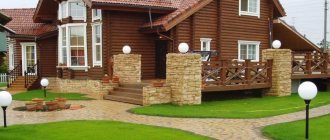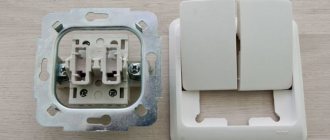Constantly switched on lighting is costly and sometimes even economically unprofitable. For such purposes, special motion sensors are installed. They are built into the power supply circuit of the lamps. In the “normal” state, this device breaks the circuit. The appearance of any object in motion in the immediate vicinity of it closes the contacts and turns on the light. This is necessary where people are only occasionally present, and is also very convenient outside buildings. Let's take a closer look at what this invention is and help you decide on a purchase.
Kinds
Motion sensors are divided into:
- Infrared. They react to heat. They are used inside buildings and are safe, however, malfunctions may occur.
- Ultrasonic. They emit waves of 20-60 kHz. The sound is reflected from the object, captured and analyzed by the device. The disadvantages are the low range; if the object moves slowly, it may not react; if you have pets in the house, it is better not to use it. A possible advantage is repelling mosquitoes.
- Acoustic. React to noise. For use in basements only.
- Microwave. An electromagnetic wave with a frequency of about 1 GHz is used. The device is compact in size and can be easily hidden by installation. According to the radius of influence, it covers a large distance, determined by the power of the transmitter and the sensitivity of the receiver. The sensor's operation is almost unaffected by the environment around it. The downside is the high price.
- Combined. The detectors combine infrared and ultrasonic wave spectra.
Next, the sensors are divided according to their location and installation:
- Outside the building. The operating radius ranges from 100 to 500 meters. Usually these are private houses, industrial enterprises and courtyards.
- Inside the building. According to the characteristics, it is selected optimally according to the area of the room. They have a short range of action. They can be located, for example, in entrances, apartments, rooms.
According to the methods of installation and installation of equipment, they are divided into:
- Wall or corner. According to the name, it is attached to the wall or to the ceiling. They have a small viewing angle, therefore, avoiding false alarms of the sensor.
- Ceiling. Mounts on the ceiling, detection angle is 360 degrees. This is very important for rooms where there are several doors.
- Built-in. Miniature models that are installed in an inconspicuous place.
According to the method of supplying electrical energy, there is a division into:
- Wired. They have a very reliable power supply, which ensures uninterrupted and virtually trouble-free operation of the room recorder. The disadvantages are the need to stretch meters of wire and search for a free outlet.
- Autonomous. Power comes from one or more batteries, which are most often located inside the sensor in the housing. Models powered by solar batteries are available. The downside is the constant monitoring of current consumption, which changes its values over time.
Based on the number of contacts they are divided into:
- Two-pin. Used in conjunction with simple lamps connected to a 220V network.
- Three-pin. They are used with different types of lamps, and are also recommended for connecting the coil of a magnetic starter, with the connection of a powerful load.
These are just the main groups into which this type of equipment is divided; there are quite a lot of them.
How the motion sensor works
There are enough ways to save energy, one of which is a sensor to turn on the light. The main factors for equipment operation are the following conditions:
- The appearance of movement in the controlled area.
- Deviation in the established indicators of the level of illumination in the controlled area.
- Change in noise level if a noise sensor is installed to turn on the light.
All objects surrounding a person, especially of organic origin (animals and humans) have a different temperature from each other, which means they emit infrared light . Inanimate objects also emit infrared color, but their temperature is closely related to changes in its environment, for example, with prolonged exposure to sunlight or close proximity to heating devices.
The principle of operation of the motion sensor is based on reading these changes, since it is equipped with a system of lenses equipped with elements responsible for recording changes in the level of infrared light called pyrodetectors . Depending on the specific model, the number of pyrodetectors ranges from 20 to 50 pieces .
Leningrad heating system connection diagram, pros and cons.
Learn more about how to clean soot from a boiler at home. Read here.
Infrared heated floor pros and cons:
https://klimatlab.com/otoplenie/tepliy-pol/infrakrasnyj-plyusy-i-minusy.html
The higher this indicator, the more objects, including small ones, the device can recognize light from. Each of the installed lenses is responsible for a specific sector in the overall controlled area. the coverage angle also changes , which can have values from 60 to 110 degrees in increments of 20 , as well as values of 180, 220, 300 and 360 degrees .
When an object moves in the controlled area, the temperature of which differs from the surrounding environment by at least 50 C upwards, motion sensors are triggered to turn on the light. As objects move, the input and output signal changes at each pyrodetector in its coverage area.
The light stays on in the room until at least one of the sensors stops receiving a temperature change signal. After there is no more movement in the controlled area, at the end of a specified time interval, the output relay is switched off and the light turns off accordingly.
For light detectors installed in a motion sensor, a characteristic feature can be called the presence of sensitivity, which is responsible for how far an object must be from them in order for movement to be noticed. The smaller the size of the object, the closer it must be located to the device for it to work properly.
When movement occurs in only one sector, i.e. If a small object moves directly or in place, then the relay does not operate and, accordingly, the light does not turn on.
Installation and installation of sensors is carried out only when the electricity is turned off.
In addition to infrared, there are other types of motion sensors for lighting:
- Ultrasonic . The principle of their operation is based on the reflection of high-frequency sounds from objects and objects in the room, or rather the results of this reflection.
- Microwaves work similarly to ultrasonic ones, but send short-wave signals into the room, triggering when their level changes as a result of reflection from objects and objects in space.
These two types belong to the category of active equipment, the infrared version is classified as passive devices.
TOP 7 best motion sensors for turning on lights
Here is a rating of the best representatives of sensory equipment.
The TOP 7 includes the following models:
- Orbit 360 degrees CIRCUMAT PRO CR white DU OB134912;
- Brennenstuhl 1170900;
- Feron Sen 30 230V 500W 5-8 cm 30 with white cable 1.5 m 22068;
- TDM DDM-02 SQ0324-0021;
- Camelion LX-28A 6438;
- Rev Ritter "Action" 110;
- EKF PROxima dd-ms-22B.
Orbis 360 degrees CIRCUMAT PRO CR white DU OB134912
Made in Spain. It has a sensitivity from 10 to 1000 Lux and a detection range of up to 30 meters, and is installed in large rooms, for example, warehouses, shops, gyms. Mounted on the ceiling, the detection angle is 360 degrees, withstands temperatures from minus 10 to 40 degrees Celsius. The device operates from the home network.
Sensor characteristics
After selecting the desired type of photo relay, you should study the technical parameters of the devices. The quality of work and duration of operation are most influenced by the following characteristics:
- operating voltage. The functioning of the sensor is ensured using a standard network (220 V), a constant voltage source (12 V);
- degree of protection. When placed outdoors, protection from dust, solid particles, and moisture is required. The protection class of the device must be IP44 or higher;
- maximum current. The parameter shows the maximum permissible value;
- operating mode settings. These include the sensitivity of the sensor, the delay period for turning off and turning on;
- temperature Range. Usually the manufacturer indicates within what temperature limits it is possible to operate the photo relay. As a rule, they are always sufficient, although it would not be out of place to clarify the lower limit of negative values;
- dimensions. The dimensions of the device are taken into account when choosing a placement location;
- power. The relay is designed for a certain voltage of the power load, and the total value (of all connected devices) should be approximately 20% less than the norm. The latter will significantly reduce the degree of wear of the device and extend its service life.
You may be interested in this Seal on the meter
Before installing the photo relay, you should determine the required technical characteristics
Important! One of the main conditions for trouble-free operation of a photosensor is a stable voltage in the network.
The photo relay can operate under temperature changes regardless of the climate
Comparison of models
For clarity, let’s create a table of the sensors we reviewed with their characteristics.
| Model | Viewing angle, degrees | Range, m | Maximum load power, W | Installation height, m | Dimensions, mm | Weight, g |
| Orbis 360 degrees CIRCUMAT PRO CR white DU OB134912 | 360 | 30 | 2200 | 7 | 140x80x175 | 340 |
| IP44 Brennenstuhl 1170900(180 degrees) | 180 | 12 | 1000 | 7 | 100x150x75 | 220 |
| Feron Sen 30 230V 500W 5-8 cm 30 with white cable 1.5 m 22068 | 30 | 0,08 | 500 | – | 79x35x19 | 61 |
| TDM DDM-02 SQ0324-0021 | 180 | 8 | 1200 | 3,5 | 86.4x60.4x98 | 180 |
| Camelion LX-28A 6438 | 360 | 6 | 1200 | 2,5 | 120x65x120 | 149 |
| Rev Ritter "Action" 110 | 110 | 12 | 1000 | 2,5 | 120x65x120 | 185 |
| EKF PROxima dd-ms-22B | 360 | 6 | 2000 | 4 | 115x25x115 | 110 |
Review of popular models
In the struggle for buyers, different companies produce sensor models that can save energy, provide the required level of illumination and have a long service life.
Top 5 popular models
1. "IEK FR-601". Manufacturer: China. Power - 2.2 kW. Operates from a 220 V network. Protection level is IP 44. Affordable price.
2. "IEK FR-602". Manufactured in China. Power - 4.4 kW. Voltage - 220 V. Protection level - IP 44. Reasonable cost.
3. “Relays and automation FR-7M.” Manufacturer: Russia. Load - 10 A. Voltage - 220 V. Protection level - IP 40. Price is above average.
4. "Zamel WZM-01/S1". Production - Poland. Load - 4 kW. Voltage - 220 V. Protection level - IP 20. High price.
5. "Elektrostandard SNS L 07". Production - Russia. Load - 3.5 kW. Voltage - 220 V. Protection level - IP 44. Average price category.
How does it work
Most devices use infrared radiation technology, because human thermal energy is in this range. An important element of the motion indicator is an optical system that reacts to the presence and change of thermal radiation in the infrared range and sends an electrical signal. The auxiliary devices then turn the lights on and off.
Pro Tips: How to Connect a Motion Sensor for Lighting
You can install and configure the product yourself. When purchasing, you need to check the availability of instructional material and follow its advice.
Note! The tracking device must be mounted in a place where it cannot be triggered by extraneous signals.
Setting scheme
Recommendations: how to install a motion sensor to turn on the light
- It is important to know that the sensitive device does not like to be moved frequently, so you need to carefully consider its location.
- In the room, in parallel with the sensor, you need to install a regular switch so that, if necessary, you can turn off the lighting manually.
- In order to prevent accidental damage to the device, it can be recessed into the wall by cutting a corresponding hole in the drywall.
The most inconspicuous and effective sensor is the ceiling one. It has a universal range and is almost invisible
- It is important to ensure that the tracking device is not exposed to sunlight, as it will disrupt the operation of the sensor.
Connection diagram
There are several schemes:
- sequential;
- parallel;
- for several sensors;
- using a magnetic starter.
In the first case, control is transferred entirely to the sensor.
If it is necessary to turn on the light for a long time and the object will not be in the coverage area, a switch is placed parallel to the sensor. When repairing a car and being under it, a person will need lighting, but his movements will not be detected. Then, upon completion of the work, it will be necessary to manually turn off the light with the switch, but it will turn on again thanks to the sensor and turn off when the object leaves the radius of the device.
In spacious rooms you need several pieces, connected in parallel and from one phase.
A magnetic starter is used when using powerful lamps or additional electrical equipment.
Types of photo relay
Based on the principle of operation, photo relays are divided into three groups:
- programmed activation;
- equipped with a motion sensor;
- with timer.
Let's look at the differences
Programmed activation. The most convenient and economical system. Programmed for a specific time of day, season, month. Can be equipped with a motion sensor with photo relay. The light sensor will be triggered in accordance with the conditions of natural light and location in the area of human action, the power is regulated by the settings.
Equipped with a motion sensor. It is used for installation above entrances, in private houses, in parks. The lamp turns on when a person approaches, which significantly saves energy and extends the life of the lamps.
With timer. The lamp will light up at a certain time of day or at a specified frequency.
The photo relay connection system for street lighting can be external or built-in. There are many things to consider when choosing a type. The lamp sensors should not be exposed to artificial light, as this will cause the device to malfunction. When attaching sensors outdoors, it is important to provide an approach for clearing snow and dirt. In addition to automatic operation, toggle switches are installed on the blocks for manual control of turning the light off and on.











